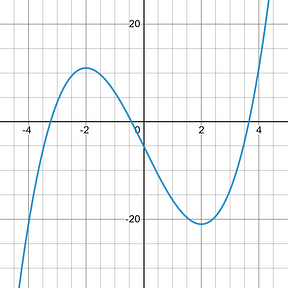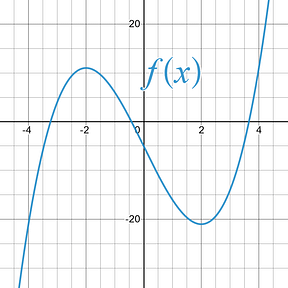Example 1: Graph the 1st Derivative, f′(x), Given the Graph of f(x).
|
Sketch the graph of the 1 st Derivative, , based on the given graph.
|
||
|
Step 1: Identify and then boldly label the graph you are working with. In this example you have been given the original graph, the graph. |
|
|
|
Step 2: Determine if you are being asked to go move down a level or move up a level. |
In this example you are being asked to move down a level. You are starting with the original graph, , and being asked to move down a level, find the derivative graph, . |
|
|
Step 3 (If you are moving down ): Mark your given graph with plus (+), minus (-), and zero (0) based on the 1 st Derivative Triangle.
|
|
|
|
Step 4 (If you are moving down ): Use your plus (+), minus (-), and zero (0) that you marked along with their estimated slope to determine the y-values on the graph you are moving down to.
The first points that you will always want to graph will be the zeros that you have marked. You know where a zero value will always be graphed, it will always be graphed on the x-axis . After that you want to work your way left to right keeping in mind that the steeper the graph the larger the number, and increasing means a positive slope, and decreasing means a negative slope. I find it helpful to use approximated values to keep track of it all. A steep positive slope I would use m=15 , or a flat negative slope I use m=-1 in my head or writing on the actual graph. If you are given a piecewise graph with constants and linear equations , you can actually use real values if needed. The derivative of a constant is always zero, and the derivative of a linear equation ( y= m x+b ) is always the m , the slope.
|
|
|
|
Final Result: In this example you would draw a final version of your 1 st Derivative graph based on the sketch from Step 4 . Remember to always make sure your final answer passes the vertical line test to ensure it is a function. The sketch of the derivative, ,given this starting graph, ,would look like:
|
||







